 4
Issue 4
4
Issue 4
Community housing models: a compelling vista of possibilities
Which community housing models – internationally and at home in the UK – work and why? How does the UK’s community housing network operate and what needs to happen for the barriers to fall so that people without extensive means can achieve the solutions they need? Future Homes for London: Alternative Models, an international conference staged by the Royal College of Art’s School of Architecture, underlined the rich potentials.
We know that community co-housing and community land trusts are not a new idea, as Kate Henderson, Chief Executive of the National Housing Federation, pointed out in ‘What more can be done to build the homes we need’ (IPPR, The Lyons Edited Collection, 2017). ‘Letchworth and Welwyn Garden Cities both included co-partnership housing models, and this has been significant in providing a unique form of tenure, combining features of a tenant cooperative with a limited dividend company’.
Today there are multiple possibilities open to communities to realise and look after their homes as social capital assets. That might sound improbable in today’s skewed housing market, but the presentations and discussions about alternative models of affordable and community-led housing projects at the conference, Future Homes for London: Alternative Models, staged at the Royal College of Art in April 2018, underlined the potential of this route out of reliance on limited and dysfunctional mass housebuilding programmes.
Curated and co-chaired with Dr Adrian Lahoud, Dean, School of Architecture, by the Royal College of Art’s Dr Tarsha Finney, Programme Leader, MA City Design, School of Architecture, the St Ann’s Redevelopment Trust, Haringey, The Architecture Foundation and the Baylight Foundation, the event offered inspiring insights about progessive global exemplars, including Swiss projects based on nineteenth-century co-operative legal structures such as Kraftwerk I and Mehr als Wohnen, Zurich, Berlin’s Baugruppen, La Borda, a new Spanish architect-led co-operative dealing with community ageing and the Melbourne-based Nightingale.
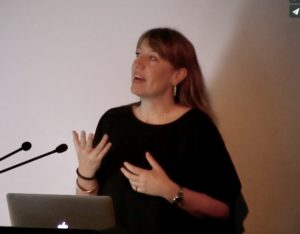
Dr Tarsha Finney, Programme Leader, MA City Design, School of Architecture, RCA.
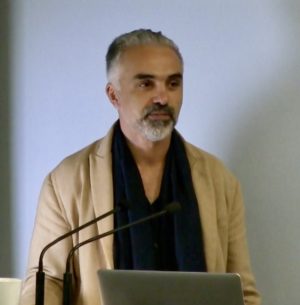
Dr Adrian Lahoud, Dean, School of Architecture, RCA.
They might apply different legal frameworks, cooperative models and land tenure systems and participation, management and governance models, but nonetheless provide valuable insights into how cooperative housing projects are financed; how they deal with patient capital and the perception of risk; how they operate their procurement structures; and deploy architecture, especially in applying design to negotiate difference.
With its high calibre of international speakers – practitioners involved in developing, building, designing, delivering and living in new projects globally – and at a time when Brexit discussions continued to drown out social welfare priorities, Future Homes for London was an ideal forum in which to consider which models work, how and why, and could be adopted by the UK’s housing scene, and adapted to its specific legal jurisdiction, financial structures, and cultural limitations. A number of people in the UK are aware that multigenerational co-housing is now increasingly built in countries like Germany. But while community groups are actively advancing projects of this kind, psychological barriers remain, including the perception that it is too difficult, or something only others can do.
The first day, Global Precedents of Community-led and -owned Housing, consisted of series of presentations by architects and housing activists operating globally. Cristina Gamboa (Lacol), La Borda, Barcelona; Jeremy McLeod (Breathe Architecture, Nightingale), The Commons, Melbourne; Christoph Schmidt (ifau. Berlin); Christian Roth (Zanderroth Architekten); Claudia Thiesen (Mehr Als Wohnen, Zurich) and Paul Karakusevic (Karakusevic Carson Architects), London. Their stories of specific projects included experiments in shared amenity both at the scale of the building block and the dwelling unit.
All these cooperative models respond to different conditions. ‘All use the design process as a mechanism for difference, which allows norms of behavior to be questioned’, said Finney. ‘Often policy makers and developers see community participation as no more than glorified consultation, or as a way to navigate the planning process’. Whereas when actual community group members talk of ‘community-led’, they mean full community control of housing and amenities, including the design process, full ownership of the property on completion, the occupants, and the fixing of rental and sales prices in perpetuity through covenants in ownership contracts, and ongoing management.
When it works, the cooperative design process led by architects, or members of coops who are architects, enables the negotiation of difference amongst the parties. Competing desires and ambitions are successfully mediated in ways that bring innovation to shared spaces and amenities of housing projects, overcoming the norms of developer-led 1-3 bedroom apartments. What, then, are the features of the participatory relationships, including conflict and negotiation, and terms realised between community and housing development and its different national contexts?
La Borda was the first housing cooperative built on public land in Barcelona, which has developing a social amenity in addition to housing for aged care facilities. Founded by a group of architects, including Cristina Gamboa, who studied formal housing access, informal housing access, housing price, right to the city, and evictions.
Gamboa explained that now in Spain people paying more than 50% of their income on housing and energy costs are very high. While formal housing access is almost always through ownership, the city has a higher percentage of rented accommodation (30%). 2% is public housing, and there are no mechanisms to control the market. Salaries are lower than before the bubble crashed, so many people leaving the city.

Cristina Gamboa (Lacol), La Borda, Barcelona.
The Sants neighbourhood of Barcelona, formerly an industrial area, has a long tradition of cooperatives. 30 years ago the municipality promised green spaces but the plan was halted in the economic crisis of 2007. In 2012 La Borda started to think how they could have an active role and provide housing ourselves. They implemented the cooperative system with 50 people of different ages and backgrounds as a non-speculative model, setting their sights on public land but open to private land possibilities.
La Borda’s principles included promoting equal relationships to realise human-scale self-managed neighbourhood based on social commitment and develop another way of urbanism making the most of existing resources. The intention was to engage the participation of people to better understand their needs and create a resilient open infrastructure and make a big effort to reduce costs by also including some self-construction.
This vision broke with the standard family model in favour of living in different ways not included in housing regulations. Some of the participants were formerly living in a squat, so they needed flexible typologies. They set environmental goals for energy, water and materials including the waste of the construction, raising consciousness about actions.
The development has 280 m2 of community areas (kitchen, dining room, co-working commercial area, multipurpose area, laundry, guest room, health area, area for bicycle) and 28 units of 10m2 each, for which participants make an initial down payment of 18,500 euros and the monthly payment is currently 450 euros per month, which is half of the market average for a 60m unit and community areas, and the land will to return to the public in 75 years time. To take care of all aspects of the projects, La Borda has three sets of general assemblies: legal, commissioning, funding, architecture, administration, shared living and project management. It has five projects ongoing and is going to increase its scope in future.
Claudia Thiesen, architect co-founder of the Mehr Als Wohnen coop (MAW), is a resident in Kraftwerk 2, their housing project, and has worked for the coop developing projects over the last 16 years. It’s important to establish good neighbourhoods and ‘participatory discussions should be fun’. The system in Zurich for cooperative housing is derived from a big tradition in operation for more than 100 years, and building coops which have 20% of all apartments.
The MAW coops are not a closed system: they have a network to which everyone can apply. Funding comes from the banks (in Barcelona they have less money from this source), with only 6% from the inhabitants, and Zurich has a municipal pension fund which puts money into the coops. The City can’t build itself but must give land to the coops. A cost rent model means long-term affordable rents. No profit is taken out.

Claudia Thiesen, Mehr Als Wohnen, Zurich.
In Switzerland housing coops are really private, and land and properties are removed from speculation. They are non-profit due to rents calculated on the effective costs, and have about 10% subsidised flats (social housing) with limitations on tenants’ income and assets. From the 1990s onwards young innovative coops have sprung up, advancing participatory processes and solidarity systems. With a maximum of 35m per person, low energy consumption, they have animated ground floors so the buildings contain not only flats but stores and offices, kindergartens, and foster different alternative living arrangements.
At Kraftwerk 2001 there are 250 people with offices, retail and common spaces, with scope for 12-14 people to live together, and a double level apartment with an enormous library, while Kraftwerk 1 Heizenholz, with 26 flats for 100 people, is a multigenerational project, with the elderly and children. Thiesen explained the notion of ‘clusterwohnung’, a shared kitchen and living room, with at the back more private rooms, and then more communal rooms and a common terrace for all, where you can easily visit your neighbours.
The Kraftwerk 1 coop moved outside the city to Zwicky Sud, creating here a mixed cluster site, with two storeys of common rooms and working spaces. Bridges across street connect the houses with their different typologies, including a bridge-cluster split into two houses, with small studios on the other side of bridge.
Thiesen explained that they could invent different types of living together for the very engaged people who live in these kinds of households. Experts advise them on how much common space they can afford and 35 groups have been established over 2 years, encompassing childcare and cultural groups. The homes have a lot of roofs people can occupy and all the balconies are connected so people can decide how to organize activities together across the mix of public and more private space. People pay rent but also money for solidarity funds, given to people to fund their projects, for example, more green facades.
R50, ifau und Jeske Fezer/Heide & von Beckerath, Berlin
When Berlin starting to suffer from big global capital investments, with rising costs, cheap housing became much harder to develop and come by unless you go to the private sector which is very expensive. A problem was that that the cooperatives were not able to build as it was so expensive to get land. The social housing problem needed to be managed but with a lack over 35 years in the city of social housing all the other programmes supporting coop projects have also been on ice.
Berlin has many open spaces dating from the post-war period on its periphery. Perimeter blocks bump into the modern layers of the city and there’s land where no-one interested in living. It is in this context that the Senate of Berlin encouraged baugruppen (housing coops) to apply, from 1980s onwards, for 1% of the land for concept-based processes. Applicants regarded them as an interesting opportunity, on the basis that the coop model offers something back to the city, such as a kindergarten, through a typical public-private partnership. Car-free cities has been a major principle but the most important priority is to create cheap living spaces.
Christoph Schmidt from ifau, Berlin, explained that they are now focusing on big housing projects outside the city. He showed R50, in Kreuzberg, a building for a community land trust, a group of freelancers, journalists, academics with a strong desire to be a community, where ifa und Jeske Fezer/Heide & (Verena) von Beckerath have created a supporting structure where the infill is made by the user, with a circular running balcony to bring the garden closer to the apartments.

Christoph Schmidt, ifau, Berlin.
Through a free floor plan they studied how people want to live and how they want to make their layouts, imagining what could be shared. Different people made reports on how they wanted to live (some didn’t want separate rooms), outlining what kind of functions and social needs could be loosely connected.
Using diagrams, the quantitive survey evolved into a qualitative one, with variations, like a Rorschach test. The building has a raw cement floor, concrete ceiling and walls, very simple pinewood frames and a pinewood façade so everyone has to vanish and polish their own part of it to help it endure for 20-25 years. The architects had broadly the same methods as La Borda, with common functions (25% of budget of each party went into the common spaces) and a blog where everyone could comment and give ideas. In Jessica Bridger’s 2015 article, ‘Don’t call it a commune: inside Berlin’s radical co-housing project’, in Metropolis, elaborating on R50, she observes that Germany is ‘where new models for housing have emerged, ones that take ideas about communal living out of the realm of hippie collectives or alt-squats and into the pragmatic territory of pooled finances and homeownership’.
Zanderrott Architekten, Berlin
Christian Roth, founder of Zanderroth Architekten, together with SmartHoming GmbH, started looking at plots in Berlin to build a house and get new projects off the ground, building for less money and shared and lower costs for the community and neighbourhood. They have been looking at cross-financing a public square, common faciities, integrating a supermarket and a school.
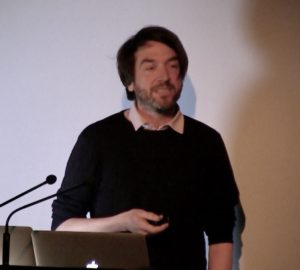
Christian Roth, Zanderroth Architekten, Berlin.
With one project they were aware of the quite difficult conditions of the location, a site facing north surrounded by Prinslaurburg. Families tend to move out of town so children can play outside. So how could they combine this need with the advantages of being in the city? The solution, a very unhierarchic building, has 3 different typologies including a townhouse with separate entrances, a penthouse with patio, a 3 storey garden house organised with split levels, over 4 storeys to get more light in.
Inside people can choose what they have, but outside is determined by the architects. The project includes some guest apartments, a sauna, kitchen, communal facilities and a grassed roof. At Liebigstrasse their structure is adaptable by adding modules, with the possibility to downsize and to rent one out. At their Mendelsohn high rise prefab buildings there will be a school building on first two floors, and a community roof terrace.
In Berlin there is no funding for land purchase so the land used by the housing coops belongs to the county. Over the last 20 years discussions have been held on how land in future can be provided for other concept-based projects and the city could get a benefit for the quarter, with the developer providing something so the city can reduce the price, a possible model for London.
Karakusevic Carson Architects, London
In the UK since the Localism Act in 2011 there has been community benefit land, but huge government cuts have made it really difficult to achieve. From 1946 to the 1980s a large number of housing completions – council houses – were delivered by the UK’s local authorities.1968 was a peak year in the UK for the delivery of homes, with 425,830 built. By 2002-3, 35 years later, this number had plummeted to a mere 180 council homes. And since then? Of the 140,660 homes that were completed in the UK in 2016, only 1.5 per cent were delivered directly by local authorities. This is in stark contrast to 1970, when local authorities in England delivered approximately 45 per cent of the 291,790 permanent dwellings completed.
But the last 13 years has seen an upsurge in councils delivering housing by themselves for themselves, and a record number of social and council homes are planned, according to the GLA. Architect Paul Karakusevic, founder of Karakusevic Carson Architects, is one of the most appropriate professionals to discuss the development of high quality housing for the public sector set against the historic context of UK housing delivery.
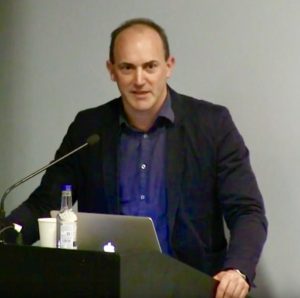
Paul Karakusevic, Karakusevic Carson Architects, London.
KCA has regenerated Colville Estate for Hackney Council, which had previously seen failed attempts to rebuild it, and residents and developer fighting. It has designed schemes like Dujardin Mews for Enfield Council, working with McCreanor Lavington, to create a range of typologies and the Bacton Estate, for Camden Council. And the first three phases of Kings Crescent estate, for Hackney, a mixed tenure neighbourhood, 100% social rent, with gardens designed by muf architecture/art, one of the few council and resident-led regeneration estates in London to combine refurbishment of existing council blocks with new homes for social rent, shared ownership and private sale.
The key challenges of mixed use development in London, said Karakusevik, include: can B2 industry remain in the city, when property values are high? How do we keep employment and industrial spaces in London, and the lack of recent precedents – few people have created work and live districts. Short leases just perpetuate insecurity. Camley Street Neighbourhood Development Plan in King’s Cross, where residents created a Neighbourhood Forum, is an excellent model.
Designated by Camden Council in 2013, following the Localism Act 2011, the Forum formed a Community Land Trust, now constituted as a limited company called Camley Street Sustainability Zone, which includes the Cedar Way Commercial Area with existing businesses including A-Models, Alara and Smithfield Daily Fish Supplies, with employee numbers rising over 3 years from 350 to 500. It was key to prevent a dominance of private sector student housing emerging in King’s Cross, and to provide truly affordable housing for residents.
The Forum has created a Neighbourhood Plan, locking in a lot of low cost housing to help keep low cost employment and food production and housing (100% affordable 900 homes and up to 1700 jobs). Conceived as a 50:50 partnership with the local residents, the Zone has entailed discussion with the Council, looking at how the CLT can work with the Council in a creative way, for best value, with a lack of central government support.
In supporting high quality affordable housing here in central London, Camden Council is seen as trailblazing. The project also increases the amount of local green space, low carbon residential and employment space, and becomes an environmental exemplar.
The Camley Street Sustainability Zone, for which some design work is evolving, is also advancing the area’s identity as a food centre (otherwise easily ending up being outside London) with premises to be rented out as most affordable rates possible. Rather than the Council taking a quick check, it is a long-term partner in the creation of lots of new affordable residential they would co-own with the trust, and lots of new jobs.
In realising the land value, there is long term revenue from rental stream of B1/housing and increased income to council from local business and residential rates. Businesses pay more rates than residential properties but that money will help local councils and to keep libraries and schools open.
Nightingale, Melbourne
Architect and developer Jeremy McLeod created quite a stir when he spoke about his Melbourne housing projects realised under the auspices of Nightingale, his firm. He also gave the full low down the night before the RCA conference at an engaging event hosted by Feilden Clegg Bradley Studios. FCBS Partner Peter Clegg invited McLeod to London after making a trip to Australia earlier in 2018 and getting to know ‘the amazing work’ being done by Nightingale. For Clegg, the Nightingale projects stand out because ‘the architects have taken charge of development. They buy sites, raise finance from banks ethical funds as well as individuals, in some cases their clients’, and ‘seem to be able to make a 15% return on investment of borrowed money’.
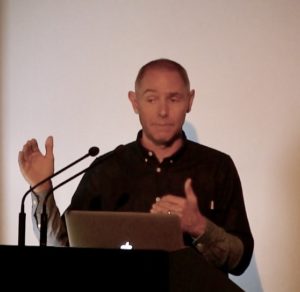
Jeremy McLeod, Breathe Architecture, Nightingale Housing, Melbourne.
Clegg described how Nightingale’s team members ‘tap into an extensive database of people interested in buying into co-housing schemes. They have social and environmental sustainability principles that run through all their schemes: shared open space and laundry facilities, and low energy design with renewables. They then develop the sites and run them pretty much as co-housing projects with a strong architectural lead. They seem to make it hugely financially attractive – approximately 30% less than open market housing – by cutting out marketing and development costs and by putting architects in charge.
Melbourne, in the state of Victoria, started as a series of villages. Now the city is spread out as one massive sprawl. Its housing model is broken, explained McLeod. In Australia there is an incredible attachment to home ownership and housing has now become an asset class. People generally won’t buy in apartment buildings so buy small, cheap and poorly built houses, with all risk on the builder. There is urban compression, with densities in some cases higher than in Hong Kong, and urban sprawl. You don’t know your neighbours. Decision makers in property development set the goal posts. The entire city has been delivered for investors over the last 20 years. Property development is a business, not an urban housing provider.
Only 3% of all housing in Australia is designed by architects, said McLeod. He started out in his career working for developers under the control of project managers, but when he dug in his heels about sustainability issues it was a non-starter, even though taking things like the plastics manufacturing out of the equation made perfect sense. For the first built Nightingale scheme, The Commons, they took a strongly sustainable, affordable, ecological and reductionist approach. Before the 2009 financial crisis Australia was a veritable land of milk and honey but then things got really hard. Everyone was pulling finance deals out of projects, so they had to find an impact investor for theirs. ‘Build more with less’ was their mantra.
Nightingale asked people what they wanted, for example, downlights, sinks, space, light, views, sun – ‘a lot of those things are free’ – rather than ‘what the marketing agents thought would sell’. The firm took the ceilings out of the scheme, exposed all the services and introduced cross ventilation so air conditioning was not needed, a big saving. Instead of chrome door hardware, they chose raw brass, and recycled timber floors, and avoided ceramic tiles as they have embedded energy.
The biggest issue was taking out the cars, a big political fight, because private homes and private car ownership in Melbourne have been intrinsically linked. This saved 10% of the construction budget. Instead of a roller door and a driveway, they put in a wine shop, sold it and used the revenue for a garden. Instead of individual laundries, a communal one was out on the roof where there were plants growing.
The Commons is sited in the Lebanese block of a suburb in Brunswick, 6 km north of the city, a melting pot of different cultures with lots of brownfield plots under renewal. Nightingale 1, their second project encouraged by popular feedback to The Commons, occupies a site across the road one back from the street and diagonally for which they paid 1.7m dollars.
McLeod can’t help but feel that Melbourne is ‘under siege by property developers’. To democratise the whole process the architects at Breathe make decisions in tandem with the people they are housing, which sounds so easy, but they raised 2.7 million dollars in equity when everyone mortgaged it (100,000 dollars each) against their own houses, and borrowed 500,000 dollars, a stressful process.
All their buildings after the Commons are mandated to be zero carbon and McLeod’s practice Breathe is both its architecture firm as well as energy supplier, buying green energy at wholesale rates (30% cheaper). ‘As architects we think we can build the armature but, at the end of the day, it’s up to the community to do’. Their work started a big discussion about car ownership, and since then in Melbourne 15 housing projects have been granted with zero cars and the Appeals Tribunal says it is ok not to have cars, a big deal in Australia.
We ‘kept looking at Baugruppen to see how they did it’, said McLeod, buoyed by the possibilities: ‘wouldn’t it be good if we could do an Australian Gropius?’. They went to impact investors and five of them put in funds. After ‘taking it out to tender to three good builders and chasing a fair and reasonable price’, each month the resident group were taken to see the builders and site, where they learned a lot about alternatives and had lots of discussions.
‘Extroverts tell you what they want – roof parties; introverts – a series of spaces’. The climate can be very hot in summer, and very cold in spring, so ‘how do you want to use your deck?’ (in the south facing building) and the plan for the winter garden. Melbourne has a temperate oceanic climate so residents needed windows that open.
They used recycled bricks at 75 cents a brick; created simple plans, with terraces facing south; open stairs, all Australian timber; used a lot of concrete; designed the building to be carbon free, with thermal mass over time to keep the building stable, no air conditioning required. The bathrooms have some Victorian bluestone on the floor, some recycled bricks and recycled Victorian ash floors. On the roof are productive gardens on the north side; in the middle, a common laundry, water tanks, a potting shed, a bee hive, landscaping on the staircase, and soundproofing.
‘I’m interested in how we house millennials’. The Commons is 65% female, Nightingale 1 is 76% female, McLeod says. ‘Some people are downsizing’. With 6 babies in the building, people wanted grass and sandpits. They also wanted a pocket park in front, to do something more, and tear up all the asphalt there, so Nightingale started lobbying the council as it was a dead end street.
When it was completed the architects moved in on the ground floor, where there is a not-for-profit cafe working with Launch Housing, a homeless charity that helps people transition into the workplace. The building opens at 7am with the cafe, and is open all day with bike parking at the back. ‘Our cities become more and more privatised so hard to find public toilets, so we have them in the café’.
The waiting list for Nightingale homes was 11 people; now it is 5200 for N2 in Fairfield, N3 and a future Nightingale Village. They have recently bought seven sites. The ‘hardest thing is finance’, McLeod admits. ‘We’re in the business of housing provision, as city makers with agency in our city. We can be architects who build housing’. At the beginning ‘we had no idea and couldn’t believe there wasn’t a better housing system. The question is, where is the real housing model?’.
There are now 15 community housing providers of affordable housing subsidised by the Australian government, as the state of Victoria doesn’t do it anymore. After 26 years of uninterrupted growth there are growing numbers of homeless people in Australia (105,000 in 2011). The housing market is volatile, and the risk averse approach generates ‘uninspiring vanilla units’. Nightingale is taking the volatility out of the process by having the buyers up front (5000 people on the list). But the biggest single risk is turning these into pre-sales and they can take a long time.
If the market turns down more than 10%, and the waiting list dries up, they will stop, he says, as it’s hard. Residents are carrying the risk up to the point the contract is signed, so that’s why they get more discount. For McLeod, the real risk lies in not sorting out our society.
Peter Clegg wanted to know how we might apply some of Nightingale’s principles in the UK even though he is ‘under no illusions about the problems of making this type of initiative work’. Would the more progressive smaller housing developers be able to extend their business model to do this?
Is it happening in Bristol, for example, where there are a number of renewable energy suppliers. On 11-12 May 2019, householders across the city opened up their homes for Bristol Green Doors, showcasing how they’ve made them more comfortable, cheaper to heat and kinder to the environment. Or how about in Blackpool where, as revealed by BBC Question Time, locals mostly hate fracking and want renewable energy industries to grow?
Today’s housing system in the UK is clearly dysfunctional. Few people believe the mantra that ‘the market will provide’ the homes they need. They understand the irony that affordable housing is very often not within the reach of many people. As the delivery of genuinely affordable and community-led housing has risen up the political agenda, this begs the question of what is genuinely affordable as well as who should housing be owned and managed by?
How can alternative models of housing be scaled up to match demand in the UK and what financing and procurement models are needed? Can public and private capital work with community organisations and philanthropy to achieve this?
St Ann’s Redevelopment Trust (StART), Haringay, London
The work of the St Ann’s Redevelopment Trust (StART), Haringay, provides an excellent answer to the question of what constitutes and legitimises a community taking control of housing projects. A group of local residents and workers who want to see the 17 hectare historic St Ann’s Hospital site there used permanently for the good of all the local community and supporting all its vulnerable members initiated a community-led process in June 2015 for 800 units of housing, community resources including shared green space integrated with health and social care facilities. They had witnessed loads of development coming on stream in run down Haringay, resulting in friends and family being forced out of the area.
Vanessa Ricketts from StART (who opened the UK Context: Community Control and Financing of Housing session with Tony Wood, StART, and Stephen Hill, National CLT Network and UK Cohousing Network on 14 April), called herself the lay person on the panel. St Ann’s Hospital was a very beautiful site, and has served the community for over 100 years. Local people all know the hospital and have attended it at one time or another. In 2018 the Barnet-Haringey Mental Health Trust decided to sell 2/3 of it to the GLA, and StART is working with the GLA to influence a community-led development on the site.
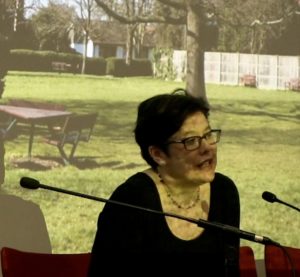
Vanessa Ricketts, StART, London.
To date they have done huge amounts of consultation, and developed a masterplan. They want to make the project so well known they can’t be ignored, and raise £50m through crowdfunding/donations as funds are very tight. At the community consultation a number of principles were agreed. Firstly, the Trust’s members control the land in perpetuity – it must not be lost to the private sector – by owning the freehold.
Homes on the land should be genuinely affordable, and based on the incomes of local people not the market. They want to control who lives on the site by ensuring a mix of people living on the site with a range of housing need responded to, as many local people live in cramped conditions, facilities in one room, and/or with young people living at home. Management should be by the community, Ricketts said. For the design of the units they have instructed architects on a brief written by a local architect, a member of StART. Green spaces and supported housing are a vital priority, so people feel interaction with the hospital site is maintained.
StART’s specific priorities include to maintain the integrity of the site, with the mental health patients part of it, to support their enablement into society, and the hospital members of the group are keen about StART’s interest in this, hence the plan for shared green border with an allotment. A private developer would put up a big wall!
The community members spoken to by StART said were happy to have high density so long as 100% affordable, so the masterplan is for 800 affordable homes. The site currently has one entrance and one exit. Where to put the cut through was an issue so they tried to design one to allay their fears about crime.
Ensuring that all these initiatives are by StART rather than working with a developer was far more likely to strengthen community cohesion. Ricketts explains that StART members are teachers, nurses, not developers, and that she’d like to see a new type of developer that doesn’t insist that they need to own the land. A Sept 2019 news update on the project is here.
Marlene Barrett (StART) explored the expectations that StART should become developers themselves, citing the inspiration of Colin Ward’s 1996 book, Talking to Architects, which explored attempts by non-architects to challenge dominant narratives of the built environment, as well as the Land Justice Network of groups and individuals which works to raise awareness of land and turn it into actions to change the status quo. She cited examples where regeneration has effectively wiped out housing, poor doors segregation, and the need to achieve genuinely affordable solutions so that no more than a third of household income paid for housing. Could the developer profit margin not could be cut out in the creation of homes, rather than remain as profit for shareholders?
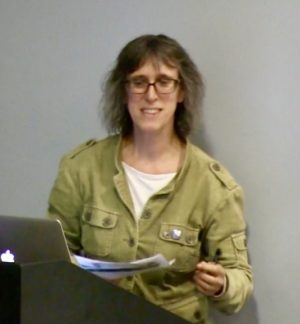
Marlene Barrett, StART, London.
Stephen Hill, National CLT Network and UK Cohousing Network Community Land Trusts (CLTs)
Stephen Hill, a board member of the National CLT Network and UK Cohousing Network, elaborated on the identity of CLTs. A form of community-led housing, they are set up and run by community members along with other social assets important to them, such as community enterprise, food growing and workspace. ‘CLTs act as long-term stewards of housing, ensuring that it remains genuinely affordable, based on what people actually earn in their area, not just for now but for every future occupier’.

Stephen Hill, National CLT Network and UK Co-housing Network.
The National CLT Network, was established in 2010 and became the official charity supporting CLTs in 2014. It got startup help from a group of charitable funders, which has contributed to the growth of the movement, along with local enabling hubs, a professional training scheme and improved technical resources. Currently in England and Wales there are over 320 Community Land Trusts and the largest Community Land Trusts have over 1000 members each. CLTs have developed 870 permanently affordable homes to date and 250 are working to develop an additional 5800 homes in the next few years. This represents a six-fold growth to the sector over the last six years.
The reason Hill, author of the paper, Property, Justice and Reason – Reconnecting the Citizen and the State through Community Land Trusts and Land Reform (April 2015) is so committed to CLTs is because of the value in the idea of all land being used for the common good, and in the public interest, as a result of individual citizens and communities doing the right thing for their place.
Central government didn’t initially make people aware of the initial funding for this sector, but then it was replaced by the Community Buildings and Housing Fund, which Hill calls an extraordinary opportunity to create housing market innovation. Through the Fund the government is making £163 million available up to 2020/21. While CLTs also rely on charitable foundations to help support new local enabling hubs and their pilot programmes, and social impact finance (applicants must prove their project will have a positive social impact), the Fund is significant because the CLT movement has managed to get government to make a national policy to enable enable local solutions.
In the mid-70s during the IMF crisis under Labour, Hill said, the Treasury was part of the bailout and happy to say state no longer had a say in funding council housing infrastructure – the party was over. Invest in infrastructure first, with a sufficient supply of social housing in any market to withstand volatility. It hasn’t ended well, and the country never got back from the situation, viewing social housing as a cost.
The problem is that no Chancellors know about land economics, he pointed out in an amusing, and galling, history of the UK’s political efforts to take action on housing. Infrastructure could be more fully financed. No-one invests it in a way that facilitates development. Whereas with state assets, under Macmillan (Prime Minister from 1957-63), 300,000 homes were being built per year, but the government could have built anything.
The state was able to capture the uplift and that’s how the New Town Corporation started. However if the state doesn’t act as the assembler of land, no-one else is going to. There is a role for the state, to acquire at a sensible price. Social housing debt is not a debt being paid back, and not being accounted for as with other countries in Europe.
Hill wants to see the UN’s Sustainable Development Goals put at the heart of communities, particularly SD Goal 11: ‘Make cities inclusive, safe, resilient and sustainable. Cities are hubs for ideas, commerce, culture, science, productivity, social development and much more. At their best, cities have enabled people to advance socially and economically. However, many challenges exist to maintaining cities in a way that continues to create jobs and prosperity while not straining land and resources.
Common urban challenges addressed by SD Goal 11 include include congestion, lack of funds to provide basic services, a shortage of adequate housing and declining infrastructure. The challenges cities face can be overcome in ways that allow them to continue to thrive and grow, while improving resource use and reducing pollution and poverty. The future we want includes cities of opportunities for all, with access to basic services, energy, housing, transportation and more’.
A key Sustainable Development goal is that ‘by 2030, enhance inclusive and sustainable urbanization and capacity for participatory, integrated and sustainable human settlement planning and management in all countries’. SDGs come with a complex set of indicators, said Hill, but CLTs need to do the measurements behind them.
Hill’s advice to new CLT groups is to work to develop a compelling narrative for what they are doing and the confidence to project that. He is full of admiration for the Camley Street project, and all similar initiatives working with councils to maximise long term value in what he calls the new long cycle era, moving to a low carbon economy, and re-regulation, and cited Building Cycles: Growth and Instability (Wiley-Blackwell, 2009), by Richard Barras, urban economist at the Bartlett School of Planning, UCL, as still of value today.
Dinah Roake, Brixton Green, London
Community control contributes hugely to social sustainability: that was one of the key messages in Dinah Roake, Chair of Brixton Green’s informative talk. Brixton Green is a south London-based CLT that has been in existence for over a decade, with over 1300 members, and is now aiming to get planning permission for ‘a homegrown solution’ for 300 homes on a 1.7ha site in Brixton, an ‘increasingly diverse’ place. ‘We are many communities’, she told us. They are 100% for rent, for all ages and abilities, built sustainably with an energy centre, and the development provides training and employment, a community hub, shops and a community theatre and cultural hub.
Brixton Green has been trying to introduce community-led housing to local authority councillors, and Roake flagged up the Cooperative Councils’ Innovation Network (CCIN) led by Croydon Council, which has a practical focus to encourage local authorities to foster cooperative, community-led solutions to the housing crisis. Local authorities can support CLTs through a mix of policy and resources: the right leadership, policy environment which includes making land available through planning policy. They can help resource CLTS through council asset transfer or sale, funding and by enabling support in the form of impact evaluations and other solutions.
Framing community control in its wider historical context, Roake started by locating us in the 1890s when Ebenezer Howard’s garden city vision was launched, taking shape most successfully in Letchworth. Why is it still relevant? Today the garden city concept – a holistically planned new settlement – remains of paramount importance to social sustainability because it redefines how we citizens value land. It is based on a local ‘cooperative of common wealth’ and land value capture for the benefit of the community, through formalised community ownership of land and the long-term stewardship of assets.
Garden city principles are vital to bear in mind, Roake said, at a time when garden towns and villages are being planned by government (an initiative was announced in the spring 2016 Budget making it easier for local authorities to work together to create garden towns with between 1,500 and 10,000 homes), through a modernisation of the New Towns Act (1946). The National Planning Policy Framework guidance (2012) originally included garden city definitions as aspirations, but apparently no longer does, leaving the term ‘garden city’ or ‘garden town’ as more of a brand. It falls to the Royal Town Planning Institute to promote them, Roake said. See planner Matthew Taylor’s article, Why we need garden villages (2016, RTPI website).
In more recent decades we have experienced the financialisation of the housing system, through structural changes leading housing to be treated as a commodity, and means of accumulating wealth. The introduction of the 1957 Rent Act and its decontrol of rents of more valuable houses and associated property profiteering helped to spur the process. But, as Roake pointed out, fast forward to today’s housing crisis and clearly ‘market forces cannot resolve housing supply, however much your political ideology wants them to’. In this context, CLTs provide security of tenure, and apply the principle of ‘common wealth’: holding land in trust for the community for 250 years. Access for all to adequate, safe and affordable housing and basic services is a UN Sustainable Development Goal (target 11.1).
Roake defined the building blocks of social sustainability as flexible, adaptable housing; neighbourhood networks; community assets; collective services; community champions; participatory decision making, and community-driven stewardship (as custodians). These principles are about the contribution community control makes to social sustainability, from space to grow, voice and influence, social and cultural life amenities and social infrastructure, connection to the local and regional economy and green building, environmental innovation, and incentives for pro-environmental behaviour.
The bonding element of social capital is fuelled by feeling in control and that residents are cared about, and Roake elaborated on what local people want, based on the participatory workshops staged by Brixton Green, in an area of London where 70% of residents rent. The wants include:
* affordable housing for rent or sale, allocated to local people.
* to provide, own or manage property for their own household.
* to be able to take control of, or to refashion, local housing services.
* to manage green spaces next to homes.
* to create resident-led housing options for older residents.
* to build new property for one or more household.
* to create eco-sensitive, low impact and green accommodation, and reduce utility use and costs.
* to live together with others sharing religious, political and other beliefs.
* to build intentional communities, places for group living and other utopian lifestyles.
* to design and build shared or intentional neighbourhoods.
* to revitalise existing neighbourhoods, and increase their quality and inclusivity.
* to generate funds to help deliver broader community services and innovation.
Adopting the solutions proposed by local people, Brixton Green accordingly operates to a principle of households paying the rent they can afford, with security. Social and market housing is not separated: all the homes are built to the same standard; everyone has the same rights and quality of service, and people on different incomes live side by side. The landlord is the Brixton Green Community Trust, which is accountable to the residents and to local people, and locks in the assets for community benefit, guaranteeing the objectives. 100% of the homes are for rent, and a long term approach to governance and finance is essential.
How would having a thousand community trusts in London influence the city? It would:
*help make sure London remained a mixed income city.
* capture the financial value created by public property to benefit the local community, through community businesses.
* help to properly maintain the buildings, so residents aren’t waiting for 30 years.
* improve access to public services.
* build social cohesion, and the expectation of active participation.
* create a backbone of neighbourhoods and help to improve their wider areas.
The scaling up of a community-led approach to new garden cities, towns and villages is possible, Roake felt, if we have:
*local experts who understand the socio-economic context, evolve solutions collaboratively and include future potential residents in discussions and engagement.
* local authority-facilitated co-production, enabling community building through community control of decision making and accountable governance of stewardship arrangements, including the use of the New Towns Act (1946) powers regarding access to land, and plan making designating land uses in an appropriate way.
* long-term ‘patient’ investment enabling lower rents, by retaining ownership, and using leasehold/CLT/cooperative.
* true affordability for all ages and abilities, with rents linked to income, not housing scarcity, and flexibility in rents applied to specific dwellings.
* land value captured for social value and benefits by using planning powers to define the needed physical, social and community infrastructure.
Totnes Community Development Society, Totnes, Devon
Frances Northrop, Principal Director for Communities and Localities, New Economics Foundation, is also involved in the Totnes Community Development Society, which takes a community wealth building approach to providing the homes society needs, giving everyone a share. Community shares and locals can become members, 1 member, 1 vote with a maximum £20K investment.
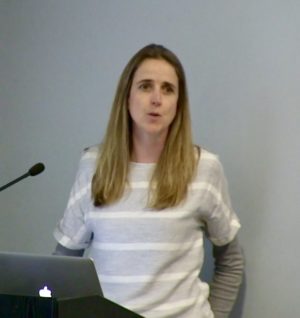
Frances Northrop, Principal Director for Communities and Localities, New Economics Foundaition.
The Society began life in a milk processing plant, led by professional people with skills. She explained the NEF campaign to save public land, because of all the land being sold off by councils, and due to the fact that only one in give of the new homes forecast to be built on public land and sold off is likely to be classified as ‘affordable’, and only 6% is likely to be social rental housing. All public land sales should be stopped, Councils should exercise their CPO powers, and a national land bank set up: ‘It’s the family silver, when it’s gone. We are tearing apart our social fabric”, she said.
Peter Gladwell, Public Sector Partnerships, Legal & General Investment Management
Pete Gladwell, Head of Public Sector Partnerships, Legal & General Investment Management, said L&G stewards a lot of society’s capital with customers paid annuities for as long as they live. He invests into assets, finding things that generate long term income streams matching the money he is paying out in annuities. L&G takes share of the blame for the broken system, he says, and is trying to create something of a new system. He quoted Barack Obama’s comment that what will replace the capitalist system is now in transition.
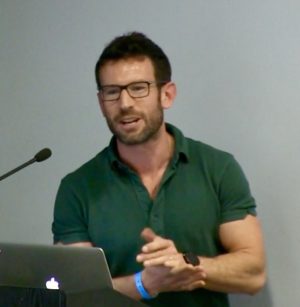
Pete Gladwell, Public Sector Partnerships, Legal & General Investment Management.
Gladwell talked about the intersection of long term social needs, and identifying and quantifying these. If investment goes to meet these, it is long-term, and can be used to pay pensions, and fund housing, care and health. The NHS needs a lot more long term patient investment. It is about getting out of our ivory tower and taking more risk, engaging more directly with community need. Local authorities sharing that vision are bringing in partners to help direct society’s long term needs.
Over the last 10-15 years there has been lots of offloading of surplus land to private developers: it’s seen as the norm. Stopping sale of public land is controversial. The NHS (which has lots of land, and is in dire straits) and Councils need to sell at the highest price, and say there is a need for fund public services, so there is a real dilemma if there are no land sales. But the LAs need income not capital receipts. He felt sure more CLT hubs will emerge so the question is how to aggregate so can access finance.
Roundtable comments
Hill pointed out the fact that land value is being used as a substitute for global taxation. This was an abdication of the government’s responsibility, said Karakusevic. In the rest of Europe housing is seen as city infrastructure, while here it is not seen as vital, if you consider London’s history of active support from bodies like the Guinness Trust established in 1890 to improve people’s lives.
10 years ago no-one cared about sustainability in real estate, but now social impact indicators represent a big consultancy sector. Social impact, and how we can create it, will be very important in the future.
After a 150 year break, do CLTs and entities such as the Sutton Trust promoting social mobilities mark a new spirit of philanthropy? Build to Rent doesn’t replace this, but is a step in the right direction. On the issue of CPOs, for example, made at the Aylesbury (CPO confirmed 2018) and Heygate estates (CPO, 2012-3) in Walworth, south London, lots of local authorities are using these powers, added Karakusevic. In the 1940s-60s they were very good at CPOs, but now it is a heavier legal process.
Since this event there has been a stepping up in the number of public discussions on UK housing as social infrastructure. Sustainable housing for Inclusive and Cohesive Cities, for example, a conference at the GLA on 10 May 2019, looked at what role housing plays in the sustainability and cohesion of a community, and what it means for local people to be in the driver’s seat. Leading figures in the community-led housing sector explored the agency and identity of CLTs, and their social impact and benefits to local economies, in the context of the emerging municipalism, with communities, local and national goverments working together.
Future Homes for Londoners opened up a compelling vista of possibilities for creating community driven homes and hubs, inspired by well chosen international examplars. For those wanting to take part in advancing UK’s growing cooperative and co-housing movement, now is the time to act.